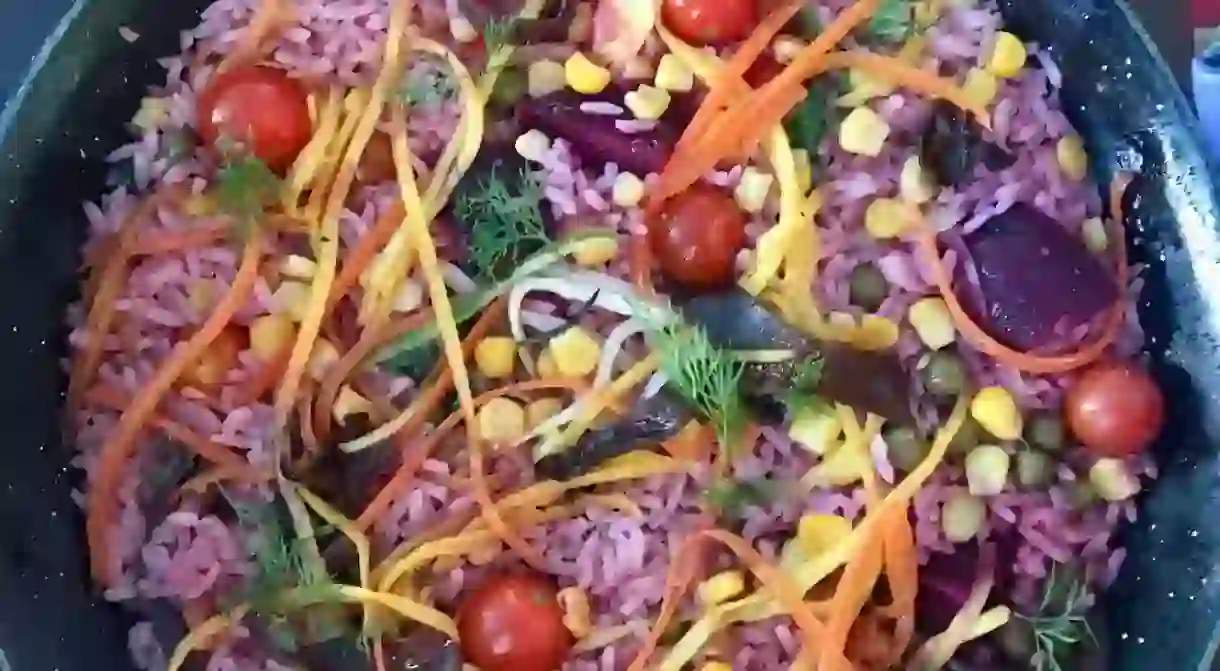Cuba's Organic Farming Revolution Is Debunking Its Reputation For Bad Food

Thanks to a small-scale organic farming revolution, Cuba is defying its stubborn reputation for the kind of bland, meagre cuisine that previously deterred traveling foodies.
In Viñales, a small town of colorful colonial bungalows and dramatic limestone hills, meals are served farm-to-fork in the purest sense. The contents of your plate—silky eggplant, hand-cut sweet potato fries, dewy heirloom tomatoes, emerald hued greens—were grown and harvested just steps away, in fertile fields belonging to the very same family who prepared the meal.
Even more incredibly, every morsel is fresh and organic, because chemical pesticides and herbicides are rare in Cuba—a fact that has propelled the country to the status of world-leader when it comes to organic farming techniques. This agricultural revolution is a fairly new development, however, and food scarcity has featured heavily in the country’s history.

The collapse of the Soviet Union in 1991, coupled with the ongoing American embargo, plunged Cuba into economic dire straits. Without its primary ally and trade partner, Cuba’s previously prosperous sugar plantations were shuttered, and serious food shortages resulted in a country-wide famine. People survived on sugar water and lost an average of 12 pounds. Some resorted to slaughtering beloved family pets—anything for sustenance.
Up until then, the Soviets, being Cuba’s benefactors, had supplied the country with petroleum and petroleum-derived chemicals for farming. Now that these two things, essential to industrial agriculture practices, were suddenly unavailable, the island unintentionally but effectively went green. Fields were tilled with animal-drawn carts and organically grown crops were harvested by hand. Community farms popped up in gardens and on rooftops, and these small-scale growers managed to revive Cuba.

“They had to rely on organic methods, and it worked so well the country became an authority,” explains Christine Dahdouh, owner of Mhai Yoga retreat center in Havana, where a team of chefs prepare vegetarian meals for guests, incorporating site-grown produce. “Other countries started sending delegates, schools started coming to learn from Cuba, and eventually [the government] decided to make it illegal to use herbicides and pesticides, for the health of the people.”
It’s not unusual to hear tourists complain about the quality of food in Cuba—of having to pack a personal supply of Tabasco to add the kick the cuisine is lacking—but it’s safe to assume most of those visitors have ended up dining in government-run establishments. “It’s not necessarily bad food—there are government restaurants that have really great, top notch stuff—but it’s just not this,” she says, gesturing to the green patchwork of fields behind her. “It’s not coming from the soil, directly from farms. You have to think of it as corporation scale. Here, everything is mama-papa or big corporation.”

Today, Dahdouh has brought her group to a family farm and restaurant named Ranchon La Margarita, after the matriarch who originally owned the land. It has a small outdoor dining area, open to birdsong and views of veggie patches, and a thatched roof to keep off the sun. The waitress shoos a chicken out from behind the bar with her foot—there’s no such things as battery farming here in Cuba.
Our table is spread with crisp deep-fried plantain chips, buttery yuca, fragrant congri (a delicious black bean and rice stew), roasted meat and honey-sweet pineapple juice, squeezed on-demand. There are so many dishes—countless servings of seasonal fruit and vegetables, we can barely find room on our overflowing plates or in our bursting tummies to sample it all. Of course, this isn’t the way the locals eat.
When Obama’s “Cuban thaw” opened the country up to American visitors for the first time in decades, many Cuban’s rushed to open their own casa particulares (homestays) and paladares (private restaurants). Demand for fresh fruits and veggies from this wave of tourists and the establishments that feed them has driven up food costs—there simply isn’t enough to go around.
At the local co-op market, where vendors used to compete for buyers’ attention, the same buyers now wait patiently in long lines, hoping there’s enough stock left for their order. Demand is so high, there’s even a black market for organic produce. And as for the Cubans who scrape by on the average state salary of $25 per month? It’s hardly worth showing up to try their luck.
These are the inevitable growing pains of a country, largely unchanged for decades, which is now undergoing a period of change. Though the move towards agroecology was not made by choice, Cuba is pioneering a model that could become increasingly important as food scarcity, driven by increasing population and climate change, becomes a global problem. It’s not a perfect system, but it is a move in the right direction.













